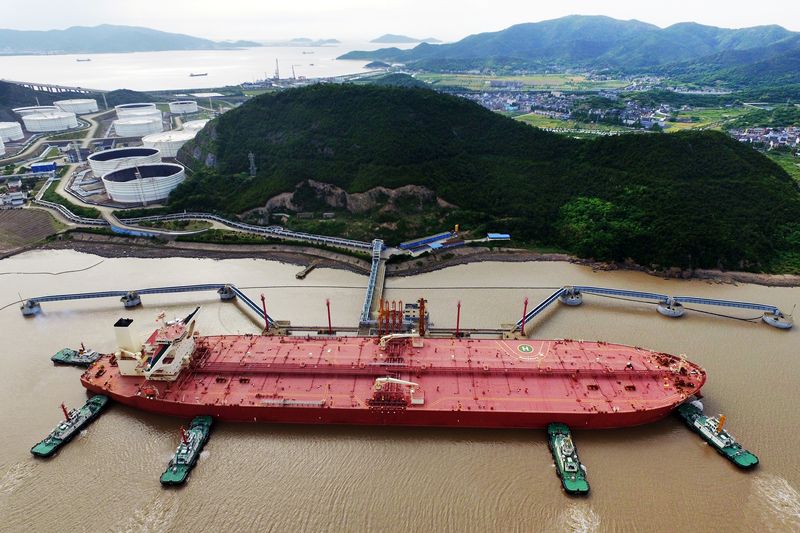Commodities
Oil shipping rates surge after US sanctions hit availability

By Florence Tan and Siyi Liu
SINGAPORE (Reuters) -Supertanker freight rates jumped after the U.S. expanded sanctions on Russia’s oil industry, sending traders rushing to book vessels to ship supply from other countries to China and India, shipbrokers and traders said.
Chinese and Indian refiners are seeking alternative fuel supplies as they adapt to severe new U.S. sanctions on Russian producers and tankers designed to curb the world No. 2 oil exporter’s revenue due to its war in Ukraine.
Many of the newly-targeted vessels, part of a so-called shadow fleet that seeks to avoid Western restrictions, have been used to ship oil to India and China, which snapped up cheap Russian supply that was banned in Europe following Moscow’s invasion of Ukraine. Some of the tankers have also shipped oil from Iran, which is under sanctions as well.
The latest U.S. action means an estimated 35% of some 669 shadow fleet tankers involved in shipping Russian, Venezuelan and Iranian oil have been hit with sanctions by either the U.S., Britain or European Union, according to analysis by Lloyd’s List Intelligence.
Freight rates for Very Large Crude Carriers (VLCCs), that can carry 2 million barrels of crude across major routes, jumped after Unipec, the trading arm of Asia’s largest refiner Sinopec (OTC:), chartered several supertankers on Friday, the sources said.
Unipec also last week snapped up several sweet crude cargoes from Europe and Africa, including 2 million barrels of Norwegian Johan Sverdrup, 1 million barrels of Senegal’s Sangomar crude, Ghana’s Ten Blend, Angolan Djeno and others, traders said.
“They must look for alternative crudes. That is the primary driver for the rally (in freight rates),” said Anoop Singh, global head of shipping research at Oil Brokerage.
Middle East crude benchmarks rallied for a second session on Tuesday, with premiums for Dubai, Oman and Murban rising towards $4 a barrel to Dubai quotes, the highest levels in more than a year, Reuters data showed. [CRU/M]
Since Friday, Unipec has booked eight tankers to ship oil from the Middle East, tanker booking data showed on Tuesday.
Other Chinese buyers, Petrochina (HK:) and Rongsheng, each fixed a tanker to transport Middle East crude, the data showed.
On a daily basis, a shipbroker said, the rate on the Middle East to China route, known as TD3C, has surged 39% since Friday to $37,800, the highest since October.
Shipping rates for Russian oil shipments to China have also jumped following the sanctions.
Freight rates for Aframax-sized tankers to ship ESPO blend crude from Russia’s Pacific port of Kozmino to North China more than doubled on Monday to $3.5 million as shipowners requested massive premiums due to limited tonnages available for that route, S&P Global Commodity Insights data showed.
Adding to tightness, sanctioned tankers are stranded outside China’s eastern Shandong province, unable to discharge following a ban imposed by Shandong Port Group before Washington’s announcement on Friday.
Tanker analytics firm Vortexa estimated that more than 85% of Russian crude voyages into Shandong were conducted by the newly-sanctioned tankers.
Analysts said tanker availability could tighten further as traders look for unsanctioned vessels to ship Russian and Iranian crude.
“We expect new ships will be pulled into the shadow fleet over the coming months, many of which will be new to this trade, tightening supply in the non-sanctioned freight market,” Kpler analysts said in a note.
The rate for VLCCs from the Middle East to Singapore has gained the most, up worldscale (WS) 11.15 from Friday to WS61.35, another shipbroker said. Worldscale is an industry tool to calculate freight charges.

On the Middle East to China route, freight jumped to WS59.70, up WS10.40, while the rate for VLCCs carrying West African oil to China rose WS9.55 to WS61.44, the second shipbroker said.
Shipping crude from the U.S. Gulf to China will now cost $6.82 million per voyage, up $360,000 since last week, he said.
Commodities
Oil prices rise; U.S. crude inventories plunge, Russia-Ukraine truce eyed
Commodities
India’s Reliance to stop buying Venezuelan oil over US tariffs, sources say
Commodities
Oil prices climb on Venezuela supply worries

 Forex3 years ago
Forex3 years agoForex Today: the dollar is gaining strength amid gloomy sentiment at the start of the Fed’s week

 Forex3 years ago
Forex3 years agoUnbiased review of Pocket Option broker

 Forex3 years ago
Forex3 years agoDollar to pound sterling exchange rate today: Pound plummeted to its lowest since 1985

 Forex3 years ago
Forex3 years agoHow is the Australian dollar doing today?

 Cryptocurrency3 years ago
Cryptocurrency3 years agoWhat happened in the crypto market – current events today

 World3 years ago
World3 years agoWhy are modern video games an art form?

 Commodities3 years ago
Commodities3 years agoCopper continues to fall in price on expectations of lower demand in China

 Economy3 years ago
Economy3 years agoCrude oil tankers double in price due to EU anti-Russian sanctions























